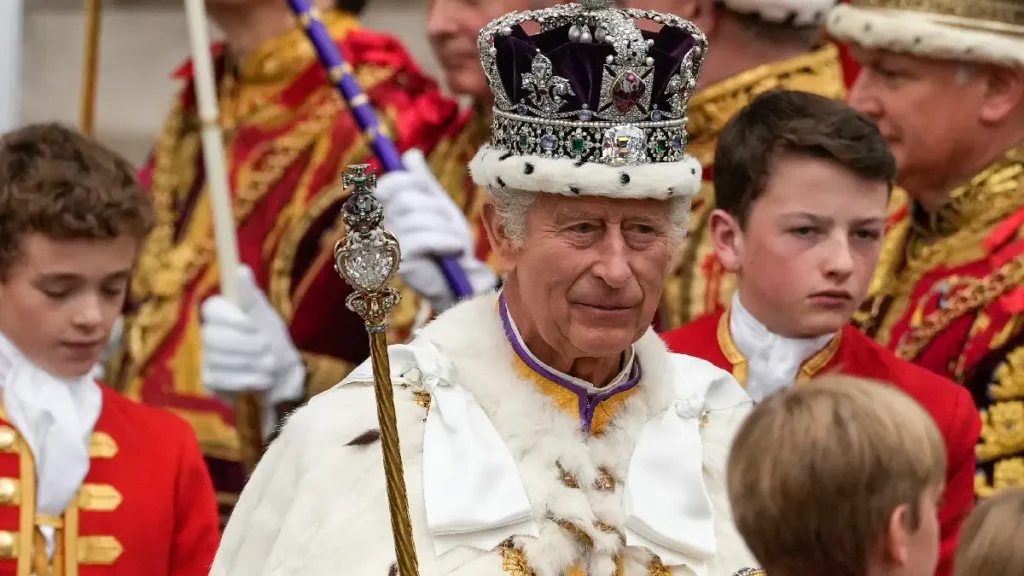King Charles III was officially crowned on Saturday in a time-honored ceremony held at Westminster Abbey, where he received the majestic St. Edward’s Crown.
This significant event took place amidst efforts by the monarchy to maintain relevance in a modern and divided Britain. With over 2,000 guests, including world leaders, aristocrats, and celebrities, the atmosphere inside the medieval abbey was filled with fanfare, as trumpets resounded and the congregation enthusiastically exclaimed, “God save the king!” Meanwhile, outside the abbey, thousands of troops, numerous spectators, and a handful of protesters gathered, creating a vibrant backdrop. For Charles, this momentous occasion marked the culmination of a journey spanning seven decades from heir to monarch.
Both the royal family and the government regarded the coronation, code-named Operation Golden Orb, as an extraordinary display of heritage, tradition, and spectacle that is unparalleled globally. The ceremony was expected to be watched by millions, yet the awe and reverence it once evoked have diminished over time, leading some to greet the day with indifference. In fact, a group of Republican protesters gathered outside, shouting “Not my king,” expressing their disdain for an institution they perceive as representing privilege and inequality in a nation grappling with deepening poverty and social fragmentation. A few individuals were even arrested.
Despite this backdrop, thousands of people from across the United Kingdom and around the world eagerly awaited the king’s arrival at Westminster Abbey. They had camped overnight along the 1.3-mile route that Charles and his wife, Camilla, traversed in a grand horse-drawn carriage adorned with gilt trim. The church itself buzzed with excitement, adorned with fragrant flowers and vibrant hats, as international dignitaries and nobles joined the congregation. Notable figures in attendance included U.S. First Lady Jill Biden, French President Emmanuel Macron, Canadian Prime Minister Justin Trudeau, eight current and former British prime ministers, and renowned celebrities like Judi Dench, Emma Thompson, and Lionel Richie.
The traditional Anglican service, slightly modified to reflect modern times, commenced with Charles, attired in crimson and cream robes, solemnly swearing on a Bible as a “true Protestant.” However, a preface was added to the coronation oath, affirming the Church of England’s commitment to fostering an environment where people of all faiths and beliefs can live freely. Notably, the epistle from the King James Bible was read by Prime Minister Rishi Sunak, Britain’s first Hindu leader. A gospel choir delivered a newly composed “Alleluia,” and for the first time in history, female clergy participated in the ceremony. Additionally, representatives from Buddhist, Hindu, Jewish, Muslim, and Sikh faiths were included.
In a captivating display of royal authority rooted in antiquity, Charles received anointing with oil from the Mount of Olives in the Holy Land, along with the presentation of an orb, swords, and scepters. Finally, Archbishop of Canterbury Justin Welby placed the solid gold crown, adorned with over 400 precious stones, atop the monarch’s head, accompanied by resounding trumpets and nationwide gun salutes.
For over a millennium, British monarchs have been crowned in grandiose ceremonies, symbolizing their legitimate right to rule. Charles becomes the 40th sovereign to be crowned in Westminster Abbey, and at the age of 74, he is the oldest monarch to ascend the throne. In contemporary times, the king no longer holds executive or political power, rendering the ceremony purely ceremonial. Charles automatically became king following the death of his mother, Queen Elizabeth II, in September. Nevertheless, the king retains his role as the United Kingdom’s head of state, representing national identity. In an era when support for the monarchy is waning, particularly among younger generations.
Nonetheless, Charles has endeavored to lead a more streamlined and cost-effective monarchy for the 21st century. His coronation was comparatively shorter than Elizabeth’s three-hour ceremony, featuring fewer guests and a condensed procession. Nevertheless, attendees were treated to a visual spectacle that included judges donning wigs, soldiers adorned with gleaming medals on their red tunics, members of the House of Lords, international royalty, heads of state, public servants, key workers, and local heroes.
In a noteworthy display of unity, the famously feuding royal family presented a show of solidarity. Prince William, the heir to the throne, attended alongside his wife, Kate, and their three children. Prince Harry, William’s younger brother who has publicly clashed with the family, arrived unaccompanied, while his wife Meghan and their children remained in California.
Towards the conclusion of the ceremony, Prince William knelt before his father, King Charles III, pledging loyalty and affection by kissing him on the cheek. Archbishop of Canterbury Justin Welby then invited everyone present in the abbey to pledge “true allegiance” to the monarch. While this moment was also extended to the television audience, it was toned down after facing criticism for being perceived as a somewhat insensitive request for a public oath of allegiance to Charles.
The contemporary audience differs significantly from those who witnessed Elizabeth’s coronation. Today, nearly 20% of the population comprises ethnic minority groups, a significant increase compared to less than 1% in the 1950s. The presence of over 300 languages spoken in British schools and less than half the population identifying as Christian further exemplifies the diverse composition of the country. Nonetheless, people from around the world and across Britain flocked to the occasion, driven by a desire to be part of this historic event.
Jill Coughlin, a devoted royal supporter from Essex, expressed her enthusiasm, stating, “It’s a joyous experience to be surrounded by love and witness the ascension of our King Charles. He represents stability and continuity for us, building upon the legacy of our beloved queen. It’s a truly wonderful moment for all of us.”

